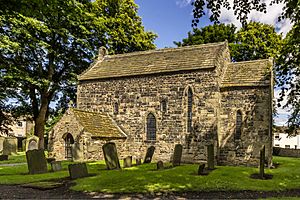Northman of Escomb facts for kids
Northman (Old English: Norþman) was an important English leader in the late 900s. He was an earl, which was a powerful noble, and his main area was in Northumbria, a region in northern England. This area was north of the River Tees.
We know about Northman from two main types of old documents. One set of documents comes from Durham, including a book called Historia de Sancto Cuthberto (which means "History of St Cuthbert") and another called the Liber Vitae (or "Book of Life"). The other document is an official paper, called a charter, from King Æthelred II in the year 994. This charter is the only time Northman is mentioned south of the Humber River. It happened the year after Vikings attacked Northumbria.
We don't know much about Northman beyond his title and the fact that he owned land and gave gifts to the church in northern Northumbria. We don't know who his parents were, or if he had any children or a spouse. His title "earl" is mentioned, but we don't know the exact area he ruled. It's possible that the two different mentions of "Northman" refer to two different people, but most historians think they are the same person.
Northman in Durham Records

One of the first clues about Northman comes from old writings kept in Durham. These writings are found in two related sources. One is a special entry in the Liber Vitae. This entry, found on page 33, is believed to be from the late 900s or early 1000s. It says that Earl Northman gave the land of Escomb to the community of St Cuthbert. Escomb is located on the River Wear, between Witton-le-Wear and Bishop Auckland.
This gift seems to have been used as a source for another important text, the Historia de Sancto Cuthberto ("History of St Cuthbert"), specifically section 31. This history likely used several such records when it was written. The text describes a "lease" (like a rental agreement) made by Bishop Aldhun. Aldhun was the bishop of St Cuthbert from about 990 to 1018. He leased lands to three different earls:
These are the lands which Bishop Aldhun [990–1018] and the whole congregation of St Cuthbert presented to these three, Earl Ethred, Earl Northman and Earl Uhtred: Gainford, Whorlton, Sledwich, Barforth, Startforth, Lartington, Marwood Green, Stainton, Streatlam, Cleatlam, Langton, Morton Tinmouth, Piercebridge, Bishop Auckland and West Auckland, Copeland, Weardseatle, Binchester, Cuthbertestun, Thickley, Escombe, Witton-le-Wear, Hunwick, Newton Cap, Helme Park. Whoever seizes from St Cuthbert any part of these, may he perish on the Day of Judgment.
Some of the places mentioned, like Weardseatle and Cuthbertestun, are not known today. The historian Ted South thought Weardseatle might be St Andrew Auckland. This list of lands is actually two groups of estates. One group is around Gainford, near the River Tees, and the other is around Bishop Auckland, near the River Wear.
Northman and King Æthelred
In 994, a person called Norþman dux (which means "Earl Northman" or "Ealdorman Northman") signed an important document. This document was a charter from King Æthelred II, often called "the Unready." The charter was a gift of 10 hides of land (a "hide" was a measure of land, usually enough to support one family) in Fovant, Wiltshire. This land was given to the church of St Mary in Wilton.
Northman was one of seven duces (earls or ealdormen) who signed this charter. He was listed sixth, just before another leader named Wælðeof dux, who was Waltheof of Bamburgh.
If these two mentions of Northman are about the same person, it's interesting because Ælfhelm, another powerful leader from southern Northumbria, also appears in the same charter. It's not clear how both Waltheof and Northman could be "dux" in northern Northumbria at the same time. During this period, Northumbria was usually thought to have only two such powerful leaders. However, this idea comes from traditions written down much later, in the 1100s. These traditions suggested there were separate earls for Northumbria north and south of the River Tees.
The historian Alex Woolf pointed out that in 993, the year before this charter, the Anglo-Saxon Chronicle (an old record of events) reported that Vikings, possibly led by Óláfr Tryggvason, attacked Northumbria and destroyed Bamburgh. After this, the English gathered an army:
(s.a. 993) In this year Bamburgh was sacked and much booty was captured there, and after that the army came to the mouth of the Humber and did great damage there, both in Lindsey and in Northumbria. Then a very large English army was collected, and when they should have joined battle, the leaders Fræna, Godwine and Frythegyst, first started the flight.
Woolf thought that Northman and Waltheof might have been in the south because of these Viking attacks. The Anglo-Saxon Chronicle also reported that in 994, the year of the charter, Óláfr Tryggvason and Sveinn Forkbeard attacked London and southern England.
We don't know when or how Northman died, or who took his place right away. We also can't connect him to any other Northumbrian earls directly. However, if the "lease" record in the Historia de Sancto Cuthberto is accurate and in order, it suggests he lived at least until Bishop Aldhun started his time as bishop, and that Uhtred of Bamburgh might have followed him.

